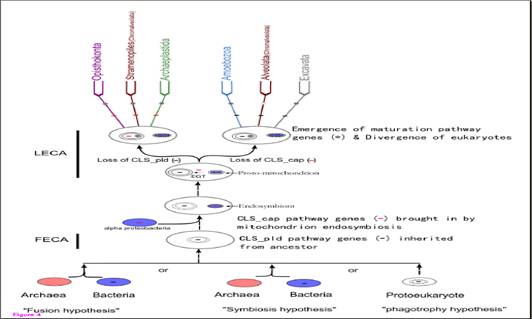
Fig. The evolutionary history of cardiolipin biosynthesis and maturation into three domains of life.
Cardiolipin is an important structural and functional component of mitochondrial inner membrane in eukaryotic cells as well as bacterial membrane in prokaryotic cells. This fact has been considered to strengthen the hypothesis of the endosymbiotic origin of mitochondria. In general, however, the biosynthesis reactions in bacterial and eukaryotic cells are catalyzed by different domain-containing cardiolipin synthases, CLS_pld and CLS_cap, respectively. Consequently, why eukaryotic cardiolipin biosynthesis is not originated through endosymbiotic event directly? How did the cardiolipin biosynthesis pathway evolve from bacteria to eukaryotes? And what happened during the consequential divergence of eukaryotic cells?
The research team “Evolutionary Genomics of Eukaryotic Cells” led by Prof. Wen Jian-fan of Kunming institute of zoology, CAS has embarked on the investigation of the phylogenetic distribution of cardiolipin synthases and maturases into three domains of life. The survey shows some interesting results: 1)CLS_cap pathway that was known as eukaryote-specific previously, has already appeared in some bacterial including proteobacteria and actinobacteria, although CLS_pld pathway exists in most bacteria. 2) CLS_pld pathway was also found in several unicellular eukaryotes, protists, although CLS_cap pathway is the canonical form in all multicellular and most unicellular eukaryotes. 3) Cardiolipin maturase is found in eukaryotes exclusively. Additional phylogenetic analyses also indicated that the eukaryotic CLS_cap has the closest relationship with that of alpha proteobacteria, while the eukaryotic CLS_ pld has no close correlation with that of any particular bacteria. And the cardiolipin maturation pathway arose after the emergence of eukaryotes. So, the evolutionary history of cardiolipin biosynthesis and maturationinto three domains of life might be clear: the first eukaryote common ancestor (FECA) inherited the CLS_pld pathway from its bacterial ancestor, and later, the endosymbiotic mitochondria brought in another one, CLS_cap pathway, into the last eukaryote common ancestor (LECA). Consequently, the protist ancestors alternatively retained CLS_pld or CLS_cap pathway, and the latter protist group has an opportunity to evolve into multicellular eukaryotes. Besides, this work indicated the maturation pathway arose after the emergence of eukaryotes, and the dynamic changes in different organisms might be resulted from adaptive evolution. The absence of cardiolipin synthesis and maturation pathways in amitochondriate protists (such as Giardia lamblia) is most probably due to secondary loss. This work furthered our understanding for the evolution of some important metabolic pathways, and the result has been officially published on BMC Evolutionary Biology recently (BMC Evol. Biol., 2012, 12:32).
This research project has been supported by 973 Program, grants from the NSFC and the Knowledge Innovation Program.
The main findings of this research can be found: http://www.biomedcentral.com/1471-2148/12/32/abstract
